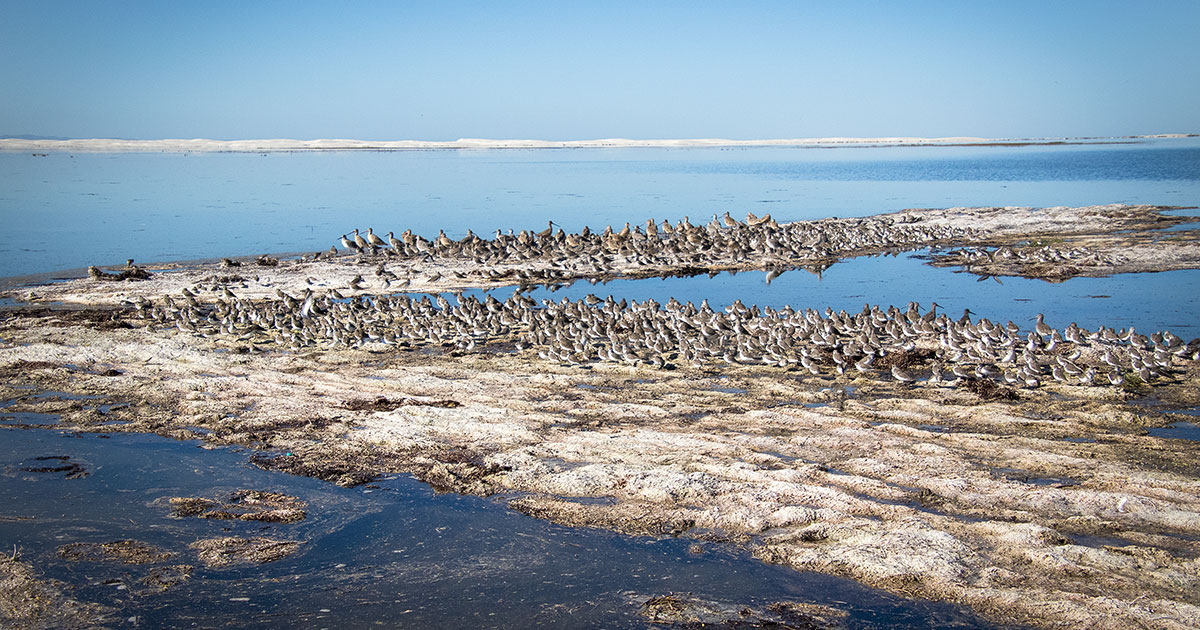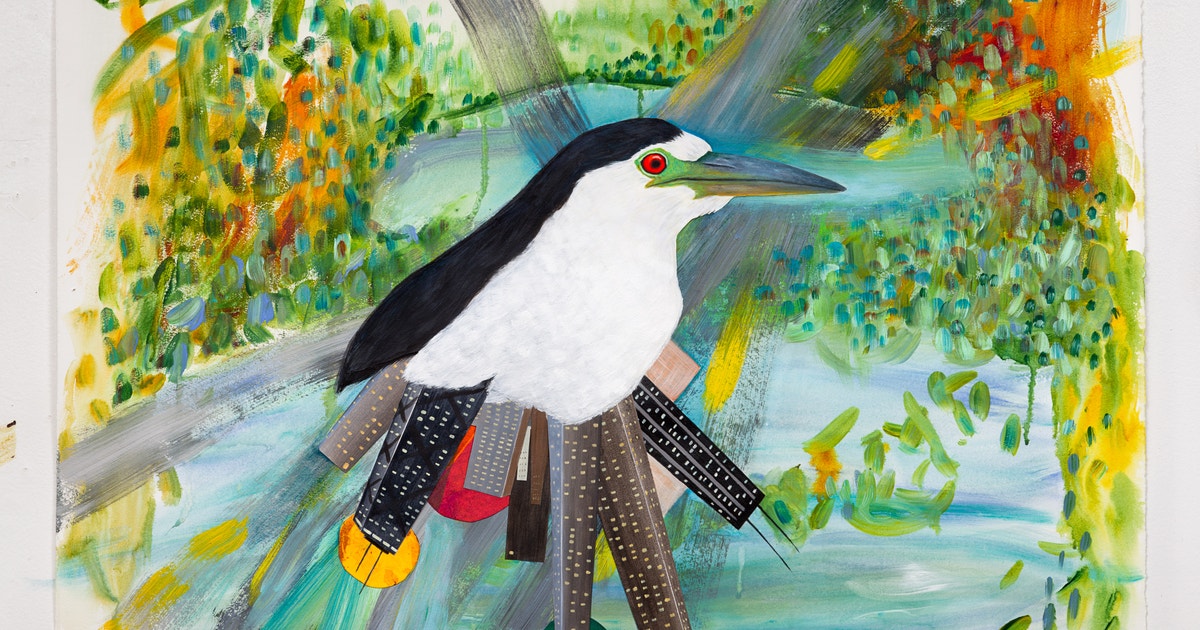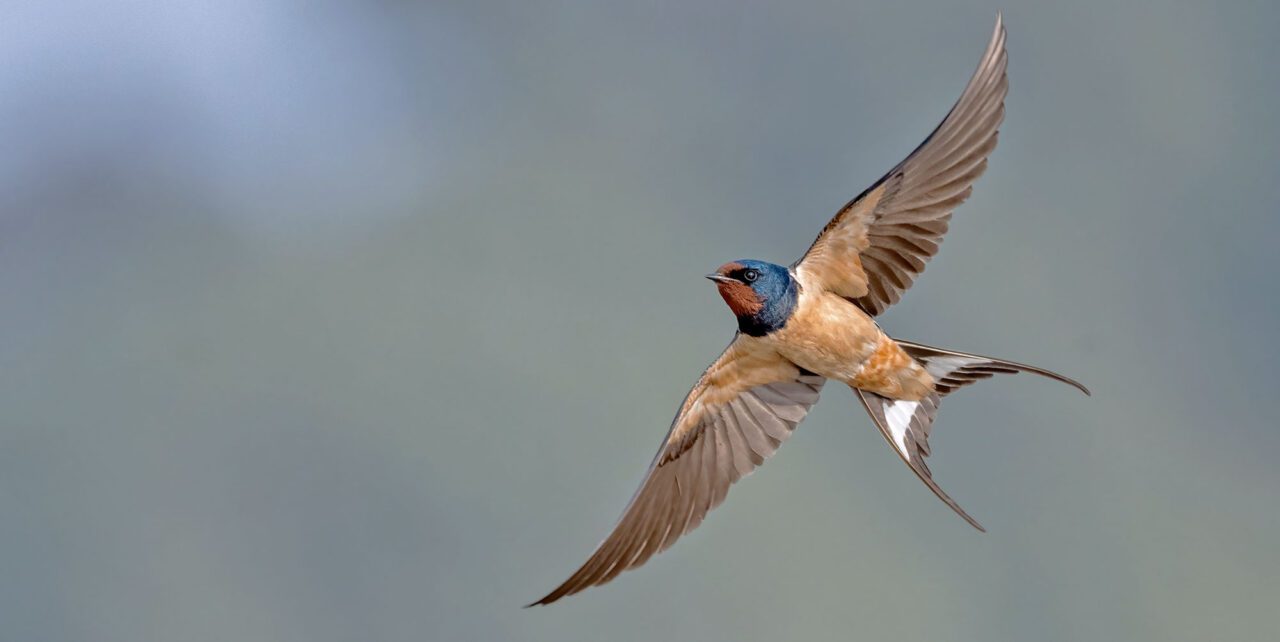On a bright November day in Baja California, Mexico, biologist Julian Garcia-Walther crouched in the cordgrass of a marsh, his face pressed to a scope. He’d spent all morning on the edge of Guerrero Negro Lagoon on the lookout for shorebirds. Down on the lagoon’s mudflats, where the birds spend all day foraging for invertebrates, his team had set traps to catch and mark the birds with GPS tags.
But the team had no luck, and now a spring tide was rolling in—one of the highest of the year, with waters six feet above low tide levels. Garcia-Walther expected to see the birds do what they normally do: As seawater covered the flats, they’d retreat to roost in the marshlands and desert landscape that wasn’t inundated. Today, however, he saw something unusual—the birds didn’t appear to be moving to higher ground, and they seemed to be bobbing gently back and forth as if floating on water.
Nonplussed, he zoomed in. “When I looked closer, I saw that they were drifting with the tide,” says Garcia-Walther, who works for the conservation nonprofit Pronatura Noroeste.
Instead of roosting among the cordgrass, Red Knots, Short-billed Curlews, Red-breasted Sandpipers, and Snowy Plovers were congregating atop floating mats of seagrass, using them as makeshift rafts. Bewildered, Garcia-Walther returned to the lagoon over the following weeks. As the tides waned with the moon’s cycle, the birds returned to their normal roosts. But a month later, he saw it again: “They were drifting along, totally oblivious that they were on a boat,” he says.
The birds, he realized, might be adapting to a lack of ideal roost sites. Typically, shorebirds roost on dunes or rocky outcroppings that are hidden from predators, undisturbed by human development, and close to foraging sites. But the high tides, likely compounded by rising sea levels, had inundated many of those safe locations. The floating eelgrass was a great hack—it allowed the birds to stay close to the mudflats where they feed and far out of reach of predators.
Loss of shorebird habitat isn’t just a problem during spring tides. In Guerrero Negro, as aquaculture, roads, and seawalls have impinged on roost sites, scientists have seen thousands of shorebirds abandon areas where they used to roost. It’s a trend scientists are seeing worldwide, says Bryan Watts, a conservation biologist at the College of William and Mary who helped launch the Shorebird Roost Registry, a project that compiles key roost locations throughout the Americas to enable their protection and management.
In South Carolina and Georgia, where Watts has conducted research, he sees rising sea levels washing away sandbars and human recreation—from picnics to off-road vehicles—scaring shorebirds away from dunes. “The shorebirds are backed further and further into a corner,” Watts says. He observes them flying 20 or more miles each day between isolated roosts and mud flats, wasting valuable energy. Because many shorebirds migrate thousands of miles twice a year, from the Arctic to as far south as Chile and Peru, every calorie counts, he says.
Inspired by the shorebirds themselves, scientists are now experimenting with the idea of building artificial roosts to help the birds find a safe space to rest. But because it’s hard to harness swaths eelgrass, Chris Purnell, wetland bird program manager for BirdLife Australia, found the next best thing: floating oyster bags, which are inexpensive mesh sacks widely used in aquaculture.
He thought of the idea while doing restoration work in South Korea’s Geum Estuary, where 20 species of shorebird refuel and recuperate on their long journey south from the Arctic. In 2006, a seawall had been built around the estuary, inundating the mudflats and leaving no space for shorebirds to roost. “You saw tens of thousands of birds circling around looking for a roost site,” Purnell says.
While brainstorming low-impact solutions, Purnell remembered seeing flocks of Red Knots congregating on mats of floating eelgrass years earlier. Not only was the eelgrass close to foraging sites and out of harm’s way, it was “chock a block” with tasty invertebrates and allowed the birds to stay cool on scorching days. He realized that floating oyster bags might provide similar benefits.
BirdLife Australia’s Floating Roost Trial, which took place in 2019, involved installing lines of oyster bags at three sites: Korea’s Geum Estuary, and Australia’s Hunter Estuary and Western Port Phillip Bay. At Geum Estuary, the effect was instantaneous. As soon as volunteers waded out of the water, shorebirds descended—as many as 54 onto a single bag. During the trial, they reported, 18 species, including the critically endangered Eastern Curlew, benefitted from the artificial roosts.
Watts, who was not involved in the work, says artificial floating roosts are an innovative solution with potential for success. The main benefit, as he sees it, is how easy it is to install them close to foraging sites, helping shorebirds save energy. “They’re in a precarious situation,” Watts says. “Providing new roosts is an important conservation strategy.”
Back in Mexico, Garcia-Walther learned about the Floating Roost Trial and was inspired. His team now plans to install artificial floating roosts in Baja California starting this fall. Instead of oyster bags, they plan on building wooden platforms piled with dead eelgrass. “We want to see if we can first attract birds to structures that mimic the floating rafts,” Garcia-Walther says. The project is in the planning stages, but the team hopes to provide relief to shorebirds whose habitat is constricted by roads, seawalls, and coastal housing developments.
Garcia-Walther is glad that his unusual sighting at the beach led him to a solution. “It’s a nice way that a natural observation can lead to conservation,” he says.




